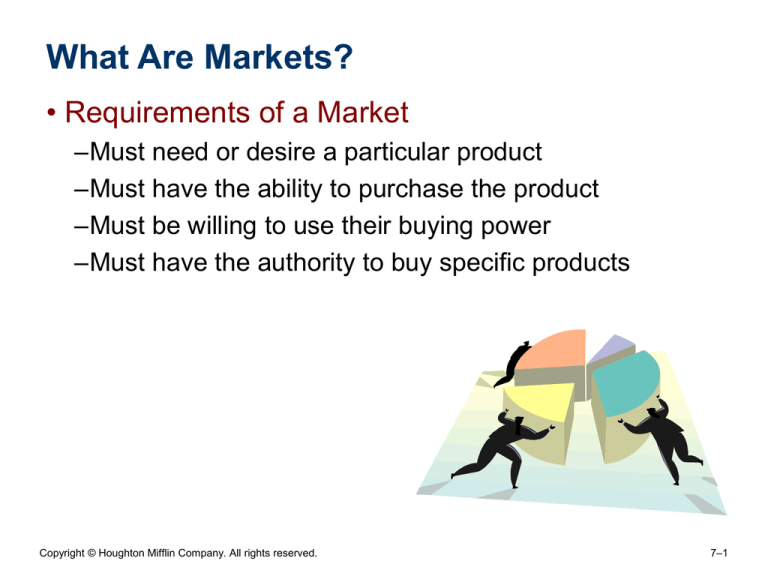
What Are Markets?
• Requirements of a Market
–Must need or desire a particular product
–Must have the ability to purchase the product
–Must be willing to use their buying power
–Must have the authority to buy specific products
Copyright © Houghton Mifflin Company. All rights reserved.
7–1
What Are Markets? (cont’d)
• Types of Markets
–Consumer markets
• Purchasers and individuals in households
• Purchases are for personal consumption, not profit
–Business markets
• Individuals and groups that purchase products for resale,
direct use to produce other products, or use in daily
business operations
• Purchasers classed as producers, resellers, government,
and institutional markets
Copyright © Houghton Mifflin Company. All rights reserved.
7–2
Target Market Selection Process
FIGURE 7.1
Copyright © Houghton Mifflin Company. All rights reserved.
7–3
Step 1: Identify the Appropriate Targeting
Strategy
• Undifferentiated Strategy
–Defining an entire market for
a particular product as the
target market (homogeneous
market)
–Designing a single market mix for,
and directing it at the total market
–Commodities: Salt, sugar
Copyright © Houghton Mifflin Company. All rights reserved.
7–4
Step 1: Identify the Appropriate Targeting
Strategy (cont’d)
• Concentrated Strategy Through Market
Segmentation
–Segmenting (dividing) the total market into groups with
similar product needs (heterogeneous markets) to
design marketing mixes that match those needs
–Concentrated targeting strategy focuses
on a single market segment using one
marketing mix --- AKA Niche Market
–Jarvis Wines – Cabernet
–Boost, Virgin Mobile
Copyright © Houghton Mifflin Company. All rights reserved.
7–5
Step 1: Identify the Appropriate Targeting
Strategy (cont’d)
• Differentiated Strategy Through Market
Segmentation
–Targeting two or more segments by developing a
marketing mix for each
–Competitive advantage is marketing
mixes are aimed at more people
–Jarvis wines: offer different types of wine to different
segments --Chardonnay, Cabernets,etc.
–Mitsubishi: entry level, SUV’s etc.
Copyright © Houghton Mifflin Company. All rights reserved.
7–6
Step 2: Determine Which Segmentation
Variables to Use
• Segmentation Variables
–Characteristics of individuals, groups, or organizations
used to divide a market into segments
Copyright © Houghton Mifflin Company. All rights reserved.
7–7
Segmentation Variables for Consumer Markets
FIGURE 7.3
Copyright © Houghton Mifflin Company. All rights reserved.
7–8
Spending Levels of Two Age Groups for
Selected Product Categories
Source: Reprinted from American Demographics Magazine, with permission. © PRIMEDIA Intertec, Stanford, CT.
Copyright © Houghton Mifflin Company. All rights reserved.
FIGURE 7.4
7–9
Step 2: Determine Which Segmentation
Variables to Use (cont’d)
• Demographic Variables
–Population characteristics such as age, gender, race,
ethnicity, income, education
• Geographic Variables
–Customer product needs are influenced by climate,
terrain, city size, population density, and urban/rural
areas
• Market Density
–The number of potential customers within a unit of land
area
Copyright © Houghton Mifflin Company. All rights reserved.
7–10
Step 2: Determine Which Segmentation
Variables to Use (cont’d)
• Geodemographic Segmentation
–Marketing segmentation that clusters people in zip
code areas and smaller neighborhood units based on
lifestyle and demographic information
–Oxford?
–Towns N’ Gowns
Copyright © Houghton Mifflin Company. All rights reserved.
7–11
Step 2: Determine Which Segmentation
Variables to Use (cont’d)
• Psychographic Variables
–Personality characteristics
• Marketers appeal to positive/favorable personal
characteristics to influence the purchase decision.
–Motives
• Marketers use individuals’ differing purchase motives to
segment a product market.
–Lifestyles
• Marketers segment markets according to how individuals
choose to spend their time in various activities, their
income, their interest and opinions, and their education.
Copyright © Houghton Mifflin Company. All rights reserved.
7–12
Step 2: Determine Which Segmentation
Variables to Use (cont’d)
• Behavioristic Variables
–Benefit segmentation
• The division of a market according to benefits that
customers want from the product
• Individuals purchase and use products that provide them
with benefits that meet their needs.
–Effective segmentation requires:
• Benefits of the product be identifiable
• Benefits actually divide market into segments
• One or more segments be accessible to the marketing
effort
Copyright © Houghton Mifflin Company. All rights reserved.
7–13
Step 2: Determine Which Segmentation
Variables to Use (cont’d)
• Variables for Segmenting Business Markets
–Geographic location
• Location affects the level of product demand.
–Type of organization
• Variations in firms’ characteristics leads to segmentation
by type.
–Customer size
• Larger customers strongly influence how they are treated
in the marketplace.
–Product use
• Firms use basic inputs in ways different from one another.
Copyright © Houghton Mifflin Company. All rights reserved.
7–14
Step 3: Develop Market Segment Profiles
• Market Segment Profile
–Describes the similarities among potential customers
within a segment
–Covers demographic characteristics, geographic
factors, benefits sought, lifestyles, brand preferences,
and usage rates
Copyright © Houghton Mifflin Company. All rights reserved.
7–15
Step 4: Evaluate Relevant Market
Segments
• Sales Estimates
– Market potential - industry
– Company sales potential - %industry
• Measuring Sales Potential
• Breakdown approach: top-down analysis
–Economic forecast
• Build-up approach: bottom-up analysis
–How much will customer purchase next year?
• Competitive Assessment
• Who, how many, how large, and how strong?
• Cost Estimates
• The expense of developing a marketing mix
• Costs of reaching segment relative to competitors’ costs
Copyright © Houghton Mifflin Company. All rights reserved.
7–16
Step 5: Select Specific Target Markets
• Issues in Selecting a Target Market
–Do customers’ needs differ enough to
warrant the use of market segmentation?
–In which market segment(s) should the
firm participate?
–Does the firm have the resources and skills
to compete effectively in the target market?
Copyright © Houghton Mifflin Company. All rights reserved.
7–17

